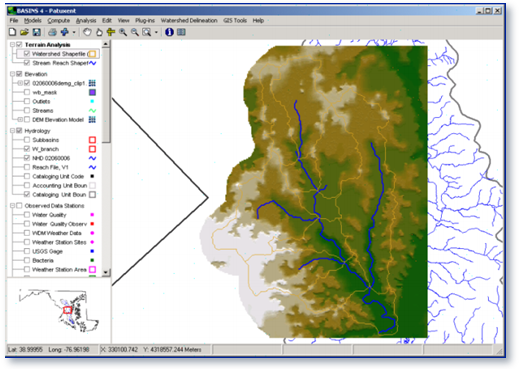Better Assessment Science Integrating Point and Non-point Sources (BASINS)
On this page:
Introduction
Better Assessment Science Integrating Point and Nonpoint Sources (BASINS) is a multipurpose environmental analysis system designed to help regional, state, and local agencies perform watershed- and water quality-based studies.
It was developed by the U.S. Environmental Protection Agency to assist in watershed management and TMDL development by integrating environmental data, analysis tools, and watershed and water quality models.
A geographic information system (GIS) provides the integrating framework for BASINS. GIS organizes spatial information so it can be displayed as maps, tables, or graphics. GIS allows the user to analyze landscape information and display relationships among data. Through the use of GIS, BASINS has the flexibility to display and integrate a wide range of information (e.g., land use, point source discharges, and water supply withdrawals) at a scale chosen by the user.
Why Use BASINS?
BASINS makes watershed and water quality studies easier by bringing together key data and analytical components in one tool. BASINS allows users to efficiently access national environmental information, incorporate local site-specific data, apply assessment and planning tools, and run a variety of proven, robust nonpoint loading and water quality models. BASINS is a useful tool for those interested in watershed management, development of total maximum daily loads (TMDLs), coastal zone management, nonpoint source programs, water quality modeling, and National Pollutant Discharge Elimination System (NDPES) permitting.

Contact BASINS Support Team
For questions about BASINS, please contact Paul Hummel (hummel.paul@epa.gov).
Citation
The preferred citation for BASINS is:
- US EPA (2019). BASINS 4.5 (Better Assessment Science Integrating point & Non-point Sources) Modeling Framework. Center for Environmental Measurement and Modeling, Office of Research and Development, Environmental Protection Agency, RTP, North Carolina. BASINS Core Manual. Accessed day month year.
